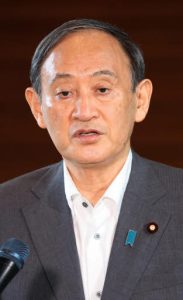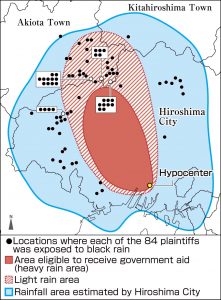Prime Minister will not appeal “black rain” lawsuit ruling
Jul. 27, 2021
Offers A-bomb certificates to all plaintiffs, hopes to offer relief more widely to aging survivors
by Seiji Shitakubo and Shigenobu Sakai, Staff Writers
Japan’s Prime Minister Yoshihide Suga remarked on July 26 that he has decided not to make a legal appeal to Japan’s Supreme Court of the “black rain” lawsuit ruling, instead accepting the ruling by the Hiroshima High Court, which upheld the original lower court decision in the first trial that recognized all 84 plaintiffs as being A-bomb survivors. The plaintiffs, who were exposed to rain containing radioactive particles, or “black rain,” that fell soon after the atomic bomb was dropped on Hiroshima by the United States, will receive Atomic Bomb Survivor’s Certificates. Mr. Suga mentioned his intent to begin deliberations on providing relief not only to the plaintiffs but also to others with complaints of damage caused by the black rain.
The direction of the national government, among the defendants in the court case, had attracted attention, with the Hiroshima Prefectural and Hiroshima City governments having already decided not to make a legal appeal and a time limit for any final appeal set for July 28. The court’s ruling that people who are also at risk of damage to health from internal radiation exposure should more broadly be recognized as A-bomb survivors will thus be formalized.
“After careful consideration, I have decided not to appeal the ruling, based on the idea that we should return to the basic philosophy of the Atomic Bomb Survivors Relief Law and provide support to plaintiffs,” said Mr. Suga as he spoke before the media in his office, revealing that he has given the necessary directives to both Japan’s Justice Ministry and the Health, Labour and Welfare Ministry. He added, “We hope to start deliberations on providing relief to those who are in the same situation.”
One of the reasons for the government’s decision was the aging of survivors. He explained that, on the other hand, “the government does not fully accept the high court’s decision.” The unacceptable portion of the ruling seems to be the broad view of health risks caused by internal radiation exposure. The prime minister’s statement on the ruling is expected to be decided at a round-robin Cabinet meeting scheduled for July 27.
Later, in his office, the prime minister met with Hiroshima Prefectural Governor Hidehiko Yuzaki and Hiroshima City Mayor Kazumi Matsui. He expressed the idea that, “I deeply considered the issue time and again.” Afterward, Mr. Yuzaki expressed his gratitude to the prime minister. “I’m so grateful that he is able to understand the pain and hardship of people who were exposed to black rain.” Obviously pleased, Mr. Matsui said, “The government’s decision will enable us to overcome issues related to administrative decisions and procedures.”
When the lower court originally ruled in favor of the plaintiffs last year in July, both local governments did not prefer to make a legal appeal from the perspective of providing timely support to the victims. However, they agreed to appeal to a higher court on the condition that Japan’s national government set up an expert deliberative committee for reverification of the scope of the government-designated area subject to black rain relief (or, heavy rain area).
People are recognized as being an A-bomb survivor based on the Atomic Bomb Survivors Relief Law if they were in the area surrounding the hypocenter or developed a radiation-induced disease as a result of exposure to the black rain in the heavy rain area.
The Hiroshima High Court said in its July 14 ruling that the boundaries of the black rain area were actually broader than those designated by the national government. It also pointed out that people could have experienced health problems by inhaling radioactive particles in the air and therefore they should be recognized as being A-bomb survivors regardless of whether or not they develop specified diseases.
Keywords
Black rain
Precipitation containing radioactive materials and soot generated by the fires immediately after the atomic bombing on August 6, 1945, is called “black rain.” Based on a survey conducted in 1945 by the Hiroshima District Meteorological Observatory, the government concluded that the black rain had fallen in an oval-shaped area about 29 kilometers in length and 15 kilometers in width. In 1976, the government designated an area measuring around 19 kilometers in length and 11 kilometers in width stretching northwest of the hypocenter as the heavy rain area subject to the relief law. Residents exposed to black rain in that area are entitled to receive free medical examinations. If such individuals are diagnosed as having any of 11 diseases designated by the government, including cancer and cataracts, they are eligible to receive an Atomic Bomb Survivor’s Certificate and thus have access generally to relief measures such as free medical care.
On the other hand, people in Hiroshima City and Akiota Town in Hiroshima Prefecture filed lawsuits in Hiroshima District Court against Hiroshima’s Prefectural and City governments between November 2015 and September 2018, seeking nullification of the decisions to reject plaintiff applications for Atomic Bomb Survivor’s Certificates with the justification that they were exposed to black rain outside the designated area. The national government, which entrusts the city and the prefecture with the task of screening for and issuing the certificate, joined the local governments in the court cases on the side of the defendants.
(Originally published on July 27, 2021)









